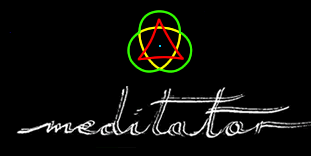
FROM MEDITATOR.ORG
Meditation Instruction
As I keep emphasising throughout this site it is best to learn meditation from a competent teacher, since it is at heart an oral tradition, where the teacher taking into consideration the specific needs of the pupil passes on the 'spirit' of the meditation. *
Nevertheless one can make a start oneself and so the following instructions might be useful.
“When the mind is left in the primordial, unmodified condition, Knowledge dawns. If that condition is maintained Knowledge is attained.”
Posture:
Take your shoes off and sit on a chair, or cross-legged, leaning neither forward nor backward nor to the sides. The spine shout be erect and the back of the neck elongated upwards. Chin should be slightly tucked in, the tip of tongue either resting behind the teeth, or touching the roof of the mouth. The shoulders must be relaxed, open, slightly pulled back and down but without tension. The open palms of the hands rest on the thighs relaxed ‘empty’, not holding onto anything, or alternatively the right hand rests on top of the left palm and the thumbs touch. The soles of both feet should touch the ground (if seated on chair). If cross legged sit either on the ground, or a cushion (it could be filled with earth, or sand) and always ensure that there is no strain on the knee or hip joints**. Eyes should be rested half-open, gazing at a point about 5 to 6 feet in front of you. Alternatively eyes could be closed.
1st practice : Inner Silence
Think neither of the past nor the future, do not analyse, initiate or engage in conversations or fantasies with yourself.
Let the body be as tranquil as a sleeping babe and the mind in its natural state. When a thought arises try to chop it down, root and all, and continue meditating. Try by mental alertness to arrest the thought process so that not even a single idea should arise. Through this practise one understands the arising and passing away of thoughts and emotions. It leads one to freedom from the tyranny of thought, resembling one who is at rest sitting by a riverbank watching the river flow past.
2nd practice : Knowledge
In the next practice be indifferent to the thoughts, allowing them to do as they please. Do not attempt to prevent them, nor fall under their spell. Be aware also of the flow of breath without interfering with it, or becoming hypnotised by its rhythm. Eventually thoughts will cease to arise and the mind will become one-pointed.
‘If the mind is left relaxed it attains tranquility, just like water which if left undisturbed attains clarity.’
Both of these practices, employing the principles of tension and relaxation, should be practised alternately since they train the mind to be in good condition. One should meditate evenly neither straining nor being slothful.
_________________________________________________________________
* The teacher
Essentially a good teacher is one who is honest, does what he preaches, has long experience in meditating, is reliable and kind. He or she will be your fellow traveller friend on a path to Wisdom.
Throughout the world, the oral tradition of meditation has managed to survive, for literally thousands of years, on a non-profit basis, by donations made from students and instruction is given free of charge as a gesture of affection to Knowledge and to help one's fellow man. Of course, nothing in this world is "free", because the way you actually pay back this debt is not with money, but with your attention and your time spent whilst doing meditation in earnest.
Finding a meditation teacher is an entirely different process from something like buying the services of a professional doctor, artist or instructor. As the saying goes when a pupil is ready to receive instruction in meditation a competent teacher will appear in his life, and the pupil must be aware enough to respond to such an opportunity when it is offered. This event has nothing to do with financial transactions, but exists because it is necessary in the larger scheme of things.
These are the wise ways that humans have used to become their own masters, and they can be intuited.
The first the question to ask oneself is: "Am I ready to meditate?"
**General points
Although to meditate all we need is a quiet moment with ourselves anywhere, and meditation can also occur at any time it helps to set it up as a regular ritual practice: 20 to 30 minutes in the morning or evening, or both, and at the same location. Of course do not let it become a boring routine! Maintain a sense of awe and 'listen' to your intuition. Avoid looking at the clock all the time, soon the body will naturally come out of meditation by itself.After meditation put your shoes on and feel the ground under your feet. It's important that one is fully aware of the body and does not re-enter the everyday world daydreaming.
Since meditation is done on a daily basis it is very important that you monitor and adjust your posture over a period of time so that the way you sit will not cause long term health problems to your body. Prior and after sitting down to meditate do some gentle stretches or loosen stiff limbs by shaking and massaging them. Don’t wear tight clothing that restricts breathing or blood circulation. While meditating don’t fidget. Often physical distractions, like itches, tiredness etc disappear by themselves as suddenly as they first appeared. If they do persist, re-check your posture.
© Byron Zeliotis January 2011
|
|
